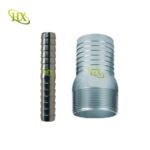Diferencias Claves entre Nipples de Acero NPT y BSPT: Guía Técnica para Selección Segura
Diferencias Claves entre Niples de Acero NPT y BSPT: Guía Técnica para Selección Segura Al seleccionar nipples de tubería de acero para su proyecto, comprender las diferencias entre las roscas BSPT (British Standard Pipe Taper) y NPT (National Pipe Taper) es crucial. Estos dos tipos de roscas no son intercambiables; usar la incorrecta puede causar fugas, fallos en conexiones o daños al sistema. 1. Qué son las roscas BSPT y NP ▸ BSPT (Estándar Británico Cónico) – Norma:Común en Europa, Reino Unido y Asia (ISO 7-1). – Ángulo de rosca:55° (forma de rosca Whitworth).pipe nipple – Sellado: Requiere sellador…


